
Lucas Industries was a major UK manufacturer of components for the motor and aerospace industries, based in Birmingham. They were basically an electrical and mechanical engineering company, but for a period in the 1960s they branched out into semiconductors. This has left a legacy of medium-power Zener diodes used in motorcycles, as can be seen by a simple eBay search. However, those are not described here. In August 1996, Lucas Industries plc merged with the North American Varity Corporation, but the Lucas brand does survive for some automotive products.
Documentation on Lucas' semiconductor manufacturing history is scarce. What does seem clear is that they entered the market later than others, and only ever made silicon devices. There appears to be no evidence that they ever experimented with germanium, but if you know otherwise, please
For a number of years starting in about 1957, Lucas manufactured silicon diodes and a range of transistors. On the Web, documentation saved from the Lucas technical library in Great King Street was published by Dave Caroline 'the archivist', however it has now disappeared. It included many images, some showing simple production lines with clean-room cabinets, staffed by women as was the custom at the time.
Most of my data come from one Lucas publication: 'silicon semiconductor products abridged data catalogue 1965'. As well as products available at that time, it contains a section on 'maintenance types' describing older diodes. If you have earlier Lucas data books or sheets, please
Lucas specialised in diodes, but it is their transistors that interest me most. All Lucas early single semiconductors have part numbers staring with D, except Zener diodes, which start with Z. Transistors start with DT, diodes with DA, DB or DD. Rectifier assemblies have part numbers starting 2DV or 2DS. Many Lucas semiconductor devices had CV series equivalents.
I do not possess all the devices below, in fact I am seeking examples and data for many of them. It is noted in the text where I am seeking examples of any particular type: if you have some for sale or exchange, please Conversely, I am happy to help anyone looking for information on these devices. The 1965 data catalogue contains characteristic data on many older Lucas semiconductors.
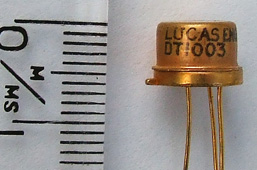
As I don't have many Lucas data books, it's hard to know which was their first transistor. A good guess is always the lowest part number, which points to the DT1003. This device has its own section in the 1965 catalogue, where it is described as a '600mW silicon diffused junction NPN high voltage transistor'. It has an hFE range of 12-36, which is rather poor. In common with most low-power Lucas transistors, it had a gold-plated TO-5 can.
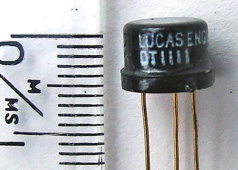
Next in numerical order are the DT1110, DT1111, DT1112, DT1120, DT1121 and DT1122. These are described as 1 Watt medium-power silicon NPN transistors featuring low collector saturation voltage, intended for use in 'military and professional circuit applications'. Each triplet is voltage-banded, and the two triplets have different gain banding.
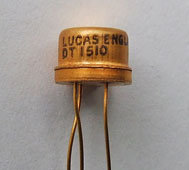
The DT1510, DT1511, DT1512, DT1520, DT1521 and DT1522 are NPN silicon '800mW medium power transistors intended for d.c. power supplies and general purpose industrial applications'. These have two gain bands and three maximum collector-emitter voltages. Again, they use a gold-plated TO-5 can.
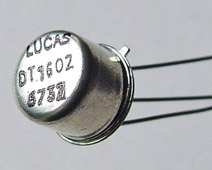
The group DT1602, DT1603, DT1612, DT1613 are 100mW low power NPN silicon types that are 'characterised for use in driving stages and intertage coupling in counting circuits employing Cold Cathode Numerical Indicators and Counting Tubes'. The first pair have a minimum hFE of 5, which is shockingly low. My image shows the DT1602 in a standard metallic TO-5 can.
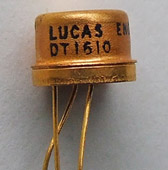
The DT1610 is also in a group of its own, identified as a '600mW transistor intended for use in low-cost industrial applications'. Its minimum hFE is 10.
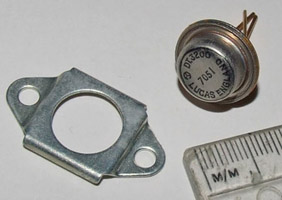
The DT3200 and DT3201 are 15 Watt medium-power NPN silicon types 'designed for use in general purpose industrial applications where low initial cost is important'. These both have hFE in the range 15-45. They employ a non-standard encapsulation with a separate mounting ring.
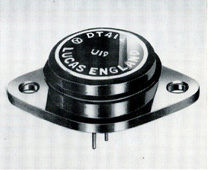
The DT4110 - DT4112, DT4120 and DT4121 are 30Watt high-power types in a TO-3 package, intended for use in 'military and professional circuit applications'. I am seeking examples of these types. If you have any for sale or exchange, please
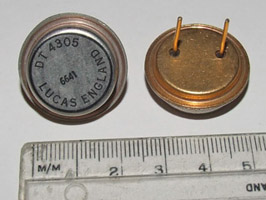
The DT4305 and DT4306 are 30Watt 500V high-power transistors for use in 'regulator, power supply regulation and inductive switching circuits'. They employ a non-standard encapsulation with a separate mounting ring, larger than the DT3200 and DT3201.
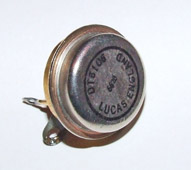
The peak power reached by Lucas transistors was achieved by the DT6105 and DT6106, which were 50 Watt 500V high power transistors for use in 'regulator, power supply regulation and inductive switching circuits'. They used the TO-36 package.
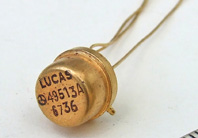
Lucas also made some transistors that were just identified by a numerical value, for example the 49513A shown. I am puzzled by the little symbol to the left of the part number. I do not have data for these types, so if you can provide any, please
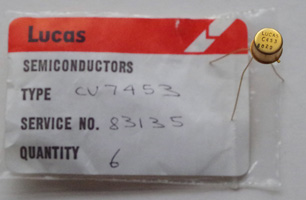
This image shows a rarity - a Lucas transistor, marked C453, but in an envelope that states that it is a CV7453 military series transistor. It has what looks like a 1980 date code, which is very late for Lucas transistors. The 1963 CV Register of Electronic Valves shows CV7453 as having the prototype 2N1481, a US type, but CV7453 was superseded by CV9863 which has prototype ZT1481, a Ferranti transistor. The case does not look like the other Lucas TO-5 types, so I wonder if they re-branded another manufacturer's device.
The Lucas transistors listed in the 1963 CV register are (there are also some Lucas diodes):
- CV9238 equivalent to DT1003
- CV7638 equivalent to DT1004
- CV8989 equivalent to DT1520
- CV9194 equivalent to DT1521
- CV9353 equivalent to DT1122
- CV9523 equivalent to DT1612
- CV9965 equivalent to DT1121
- CV9966 equivalent to DT4112
- CV10693 equivalent to DT1013
- CV10844 equivalent to DT4306
- CV10875 equivalent to DT6106
I have none of these. If you know anything about Lucas' CV types, please
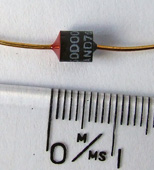
Now we start to consider Lucas diodes. The lowest current types that they produced were in the 0.5 Amp DD0nn range of silicon diffused junction rectifiers, which used a very small plastic encapsulation. The image shows the DD000, which is the lowest voltage rated member of the series DD000, DD003, DD006, DD056 and DD058.
There were several other series of diffused junction rectifiers, of increasing current capacity:
- the DD2nn and DD20nn series: 0.75 to 1.5 Amps
- the DD30nn series: 2.5 Amps
- the DD40nn series: 6 Amps
- the DD45nn series: 10 Amps
- the DD56nn and DD61nn series: 18 - 25 Amps
- the DA77n series: 35 Amps
- the DB7nn series: 35 Amps
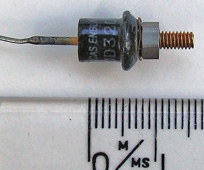
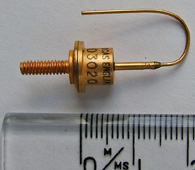
My 1965 Lucas booklet has a page showing a 'supersession chart' listing older types that have been superseded. The image on the far left shows the DD320 that was replaced by the DD3020 to its right. These are 50V 2.5A rectifiers.
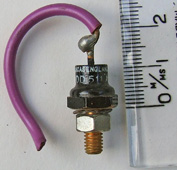
The DD511 shown on the right is another superseded type, replaced by the DD4521, which I do not possess. It is a 100V 10 Amp rectifier. It is also included in a list of 'maintenence types' which suggests that it may have still been manufactured in parallel with its replacement.
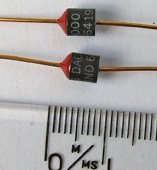
Lucas also made two series of controlled avalanche rectifiers. The DA0nn types were rated at 0.5 Amp, and the DA2026 and DA2068 at 1 Amp. The description says 'The devices are silicon diffused junction rectifiers having controlled avalanche breakdown voltages combined with all the advantages of the standard series. They are ideal for low-cost industrial applications requiring a high degree of reliability'.
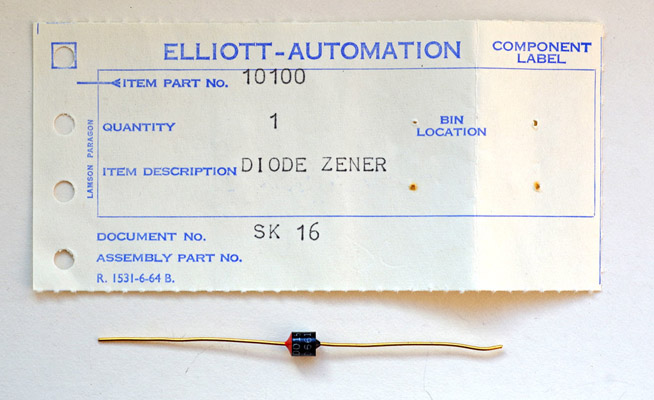
My booklet describes three series of voltage regulators, that is, Zener diodes. Lucas went on to make many more of these, but the 1965 booklet only contains:
- the ZC0nn series: 600mW types in the same small plastic package as the DD0nn rectifiers
- the ZC20nn series: 1.8W types in the same package as the DD2nn rectifiers
- the ZC40nn series: 10W types in the same stud package as the DD40nn rectifiers
In particular it does not include this type ZD015 in the same small plastic outline as the DA and DD types, shown with the Elliot Automation label that came with it.
My booklet also describes four types of rectifier assemblies, which are, as the name suggests, multiple diodes wired into a single assembly. Most of these resemble finned metal rectifiers, although one is a cuboid plastic bridge rectifier.